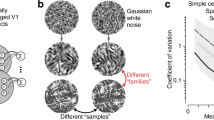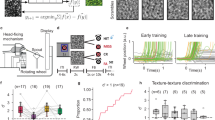Abstract
Texture perception has frequently been studied using textures constructed by repeated placement of micropatterns or texture elements. Theories have been developed to explain the discrimina-bility of such textures in terms of specific features within the micropatterns themselves. For example, Beck1,2 observed that a region filled with vertical Ts is readily distinguished from one filled with tilted Ts but not from one filled with vertical Ls. He attributed this to the different distribution of oriented line segments present in the former case but not in the latter. However, Bergen and Julesz3 found that a region of randomly oriented Xs segregated from one filled with randomly oriented Ls, in spite of the identical distribution of oriented line segments in the two cases. They suggested that this discrimination might be based on the density of such features as terminators, corners, and intersections within the patterns. We note here that simpler, lower-level mechanisms tuned for size may be sufficient to explain this discrimination. We tested this by varying the relative sizes of the Xs and the Ls; when they produce equal responses in size-tuned mechanisms they are hard to discriminate, and when they produce different size-tuned responses they are easy to discriminate.
This is a preview of subscription content, access via your institution
Access options
Subscribe to this journal
Receive 51 print issues and online access
$199.00 per year
only $3.90 per issue
Buy this article
- Purchase on Springer Link
- Instant access to full article PDF
Prices may be subject to local taxes which are calculated during checkout
Similar content being viewed by others
References
Beck, J. Percept. Psychophys. 1, 300–302 (1966).
Beck, J. Percept. Psychophys. 2, 491–495 (1967).
Bergen, J. R. & Julesz, B. Nature 303, 696–698 (1983).
Caelli, T. Spatial Vision 1, 19–30 (1985).
Knuttson, H. & Granlund, G. H. (1983) IEEE Workshop of Computer Architecture for Pattern Analysis and Image Data Base Management 12–14, Pasadena (IEEE Computer Society Press, Washington DC, 1983).
Voorhees, H. & Poggio, T. Proceedings, First International Conference on Computer Vision, 250–258, London (IEEE Computer Society Press, Washington DC, 1987).
Bergen, J. R. & Adelson, E. H. J. opt. Soc. Am. A3, 99 (1986).
Voorhees, H. & Poggio, T. Nature 333, 364–367 (1988).
Author information
Authors and Affiliations
Rights and permissions
About this article
Cite this article
Bergen, J., Adelson, E. Early vision and texture perception. Nature 333, 363–364 (1988). https://doi.org/10.1038/333363a0
Received:
Accepted:
Issue Date:
DOI: https://doi.org/10.1038/333363a0
This article is cited by
-
Predicting how surface texture and shape combine in the human visual system to direct attention
Scientific Reports (2021)
-
Perception and decision mechanisms involved in average estimation of spatiotemporal ensembles
Scientific Reports (2020)
-
Pattern randomness aftereffect
Scientific Reports (2013)
-
A gloss on surface properties
Nature (2007)
Comments
By submitting a comment you agree to abide by our Terms and Community Guidelines. If you find something abusive or that does not comply with our terms or guidelines please flag it as inappropriate.



